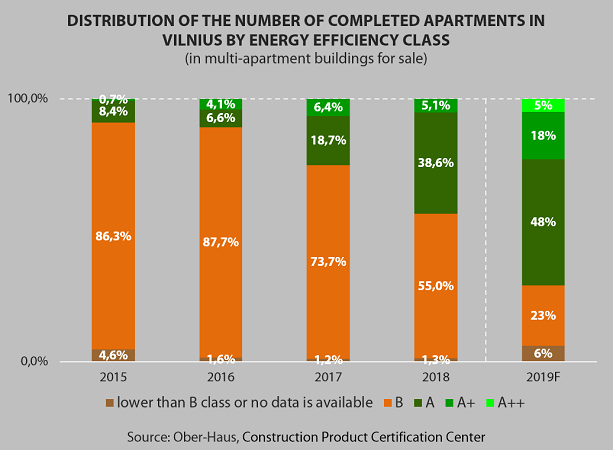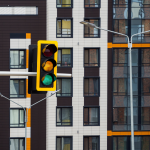In 2019, about 70% of the apartments built in Vilnius will be in A class or higher energy efficiency buildings
 Over the past three years, great quantitative and qualitative changes have been taking place in the Lithuanian construction sector and the real estate market. On 1 November 2016, amendments to the Construction Technical Regulation came into force in Lithuania, whereby newly designed and built buildings had to comply with not less than A class energy performance requirements (except for reconstructed, renovated or repaired buildings or their parts, which are subject to other minimum requirements under certain conditions, or the buildings not subject to the minimum energy performance requirements). Since 1 January 2018, the energy performance requirement for the buildings has been not less than A+ class and from 2021 the energy performance requirement for new buildings will be not less than A++ class.
Over the past three years, great quantitative and qualitative changes have been taking place in the Lithuanian construction sector and the real estate market. On 1 November 2016, amendments to the Construction Technical Regulation came into force in Lithuania, whereby newly designed and built buildings had to comply with not less than A class energy performance requirements (except for reconstructed, renovated or repaired buildings or their parts, which are subject to other minimum requirements under certain conditions, or the buildings not subject to the minimum energy performance requirements). Since 1 January 2018, the energy performance requirement for the buildings has been not less than A+ class and from 2021 the energy performance requirement for new buildings will be not less than A++ class.
In order to assess the progress achieved in building energy efficient buildings, it is rational to speak about housing developers and more specifically about Vilnius, a clear leader in developing multi-apartment buildings and trying out innovations even before they enter into force. After all, back in 2012, a multi-apartment building built in Vilnius was first in Lithuania to be certified for A class energy efficiency (a multi-apartment building on Bajorų Road, developer – Hanner). At that time some developers began preparations for the upcoming changes in the construction sector and the real estate market and practically invested in designing and building more energy efficient and convenient buildings to residents.
“It is obvious that in 2015 the share of A class energy performance multi-apartment buildings (not to mention even higher energy class multi-apartment buildings) in the new construction market was very small and increased at a faster rate only in subsequent years,” Raimondas Reginis, Research Manager for the Baltics at Ober-Haus, said. Ober-Haus has collected information about all multi-apartment buildings built in the city of Vilnius and its environs in 2015-2018 and, based on the information of the register for building certification available at the public institution Construction Product Certification Center, has calculated how many apartments are available in the buildings of different classes of energy performance (multi-apartment buildings).
According to the data of Ober-Haus, the obtained data show that in 2015 apartments in A and A+ class multi-apartment buildings accounted for only slightly more than 9% of the apartments built in that year in Vilnius and its environs. The share of such apartments in 2016 was almost 11% and in 2017 it increased to 25%. In 2018, apartments in B class energy performance multi-apartment buildings dominated (55%), but a rapid growth in the number of apartments in higher energy efficient buildings was also observed. In 2018, the share of apartments in A and A+ class multi-apartment buildings accounted for almost 44% (A class – 39% and A+ class – 5%). The remaining part of the apartments (1%) were in lower than B class energy performance multi-apartment buildings or the data on the energy efficiency class of such buildings was not available (these are usually reconstructed buildings or parts thereof or actually completed, but not yet certified buildings).
“As we can see, evident changes were taking place in 2015–2018 in the construction of new multi-apartment buildings. In 2019, we will see a further increase in more energy efficient buildings in the capital city – not only A or A+ class multi-apartment buildings, but also A++ class buildings, which are almost zero energy buildings and which are being settled already by their first residents,” Mr. Reginis said. According to the public institution Construction Product Certification Center, this year the first A++ class energy performance multi-apartment buildings will be certified in Lithuania – all of them in Vilnius: a multi-apartment building on Peteliškių Street (developer – Peteliškių Parkas), three multi-apartment buildings in Šaltinių Namai | Attico project on Aguonu Street (developer – Pro Kapital) and a multi-apartment building on Tvankstos Streeet (developer – Eika).
According to preliminary data of Ober-Haus, apartments built in A++ class energy performance buildings in the country’s capital city this year will account for about 5%, in A+ class buildings – 18%, in A class buildings – 48% and B class – 23% of all apartments built in 2019. No information is currently available about the energy efficiency parameters of the remaining newly built apartments (6%). Thus, the share of apartments in A class and higher energy efficiency buildings built in 2019 will be 70% (in 2015–2016 it was only 9–11%).

In view of the fast changes which have occurred in the past 4-5 years, real estate developers, designers and builders have managed to adapt to new construction technical requirements fairly quickly and some of them get ready for changes in advance. Buyers accept changes positively and understand the benefits of higher energy efficiency and more comfortable homes.
“However, buyers are not specifically looking for higher energy efficiency class and understand that the higher the efficiency class the higher construction costs for the developer and the higher the purchase price, which the buyers have to pay at least partly,” Mr. Reginis noted. The future maintenance costs of additional equipment in the buildings, at least partly, will also have to be borne by buyers. Therefore, with further increase in the construction volumes of higher energy performance buildings, all market players will have to learn not only how to build, but also how to properly maintain the properties built.
Latest news
 All news
All news

“e-market city” completes its second phase – the development of a modern “stock office” type shopping town continues
"e-market city", an online and wholesale shopping town located in a business-friendly location at the intersection of Eišiškių pl. and Geologų Street, is rapidly approaching the end of its second phase. The final construction works are currently underway and the first tenants of the new phase are preparing to move in as early as June-July. "The predominant floor areas of e-market city - ranging from 370 to 960 m² - are easily combinable and adaptable to a wide range of commercial activities. Existing and potential tenants appreciate the easy accessibility, high quality of construction and fitting-out, functional layout and solid neighbourhood, where well-known companies such as Assa Abloy, Dextera, Skuba, Skuba, Maidina, Šildymas plius, YE International, etc. are already located. The first phase is already 100% leased, while the second phase is still available - we invite you to get in touch", says Remigijus Valickas, Commercial Real Estate Projects Manager at Ober-Haus. The project is being developed in three phases on an area of 3.9 ha. The total area of the buildings will exceed 20,000 m² and the total investment in the project will amount to more than EUR 25 million. For more information about the project and leasing opportunities,…

The recovery of a very strong-looking housing market may slow down
The Ober-Haus Lithuanian apartment price index (OHBI), which follows changes in apartment sale prices in the five biggest Lithuanian cities (Vilnius, Kaunas, Klaipėda, Šiauliai and Panevėžys) increased by 0.5% in March 2025. The annual apartment price growth in the biggest cities of Lithuania was 4.3% (a 4.1% increase was recorded in February 2025). In March 2025 apartment prices in Vilnius, Kaunas, Šiauliai and Panevėžys increased by 0.4%, 1.3%, 0.4% and 0.2%, respectively, with the average price per square meter reaching EUR 2,680 (+10 EUR/sqm), EUR 1,846 (+24 EUR/sqm), EUR 1,172 (+4 EUR/sqm) and EUR 1,149 (+2 EUR/sqm). In the same month, apartment prices in Klaipėda decreased by 0.1% and the average price per square meter dropped to EUR 1,752 (-2 Eur/sqm). In the past 12 months, the prices of apartments increased in all the biggest cities in the country: 3.3% in Vilnius, 5.6% in Kaunas, 5.4% in Klaipėda, 6.5% in Šiauliai and 6.4% in Panevėžys. "At the beginning of 2025, the country's housing market is showing impressive results. After a very strong growth in housing transactions in January and February this year, the increase in the number of transactions continued in March. According to the data of the State Enterprise…

Housing market has woken up, but no faster price growth yet
The Ober-Haus Lithuanian apartment price index (OHBI), which follows changes in apartment sale prices in the five biggest Lithuanian cities (Vilnius, Kaunas, Klaipėda, Šiauliai and Panevėžys) increased by 0.4% in February 2025. The annual apartment price growth in the biggest cities of Lithuania was 4.1% (a 4.0% increase was recorded in January 2025). In February 2025 apartment prices in Vilnius, Kaunas, Klaipėda, Šiauliai and Panevėžys increased by 0.3%, 0.1%, 0.8%, 0.8% and 0.9%, respectively, with the average price per square meter reaching EUR 2,670 (+7 EUR/sqm), EUR 1,822 (+2 EUR/sqm), EUR 1,754 (+13 EUR/sqm), EUR 1,168 (+10 EUR/sqm) and EUR 1,147 (+10 EUR/sqm). In the past 12 months, the prices of apartments increased in all the biggest cities in the country: 3.2% in Vilnius, 4.1% in Kaunas, 6.2% in Klaipėda, 6.6% in Šiauliai and 6.7% in Panevėžys. ‘As predicted, a rapid annual growth in the number of housing transactions is recorded at the beginning of 2025. According to the data of the State Enterprise Centre of Registers, 40% more apartments were purchased in the country in January this year and 39% more in February this year than in the same month in 2024. It should be noted that in the…
 All news
All news


